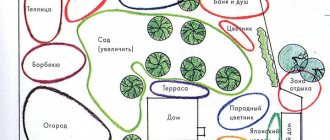Types of cinquefoil are divided into 500 names; there are subspecies with flowers of different shades: white, yellow, pink and red, orange, for example, Red Ice shrub cinquefoil.
Cinquefoil bushes are upright bushes that tolerate pruning well. Shrub species grow up to 1.5 m in height and up to 1 m in width.
If the plant is exposed to direct sunlight, the color of its flowers becomes paler.
Orange flowers
This is Red Ice bush cinquefoil - a low bush about 50-60 cm high and up to 1 m wide. Red Ace plants have lacy pale green leaves and coral-hued flowers.
The outer part of the petals is orange-pink in color. The variety blooms from early summer and blooms until October. Red Ace plants like shady, moist locations.
Cinquefoil Daydown is a bush that grows up to 70 cm in height, its crown width is 1.2 m. The flowers are rusty-red. They appear from May to October.
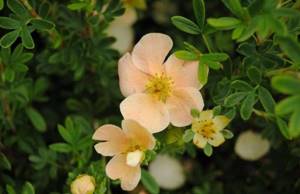
Potentilla fruticosa cultivar Tangerine is a dense, low shrub with a rounded crown. It has greyish-green leaves.
Those flowers that grow in the sun are golden in the center, and the edges of the petals have a copper tint. If the plant grows in the shade, then its flowers are orange.
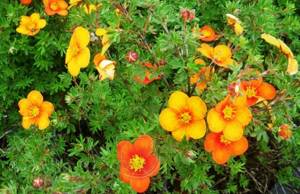
Potentilla fruticosa cultivar Hopley Orange is a 50 cm tall shrub with a crown width of approximately 1 m. It produces dark orange flowers in May and continues to bloom until early October.
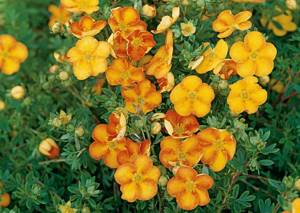
Planting and growing
Cinquefoil: planting and care in open ground includes preliminary work on preparing planting holes to a depth of 50-60 cm. Before this, they dig up and level the ground on the site. The holes provide drainage to a layer of 20 cm, a mixture of leaf soil with humus and sand (2:2:1), and complex mineral fertilizers. After the bushes have adapted and before the cinquefoil begins to flower, fertilizing is carried out with phosphorus and potassium fertilizers according to the instructions.
In hot, dry summers, watering 3 times, 10-12 liters per bush, is provided. After this, loosen the soil to a depth of 5-10 cm and cover with mulch.
White flowers
White cinquefoil is a variety of Abbotswood, it is a small bush that grows up to 1 m in height.
It has a cushion-shaped, dense crown and pale green leaves. It blooms in early summer and blooms until October.
Flowers of the Abbotswood variety are collected in small or single racemes. In landscape design, the variety is used when planting in rock gardens and creating borders.
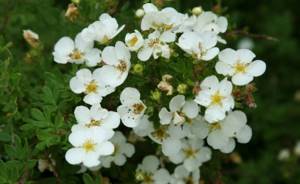
Potentilla fruticosa cultivar Veitchii is a white cinquefoil, but the flowers have faded red stamens. The bushes grow in the shape of a ball, since they are 1.5 m in width and height.
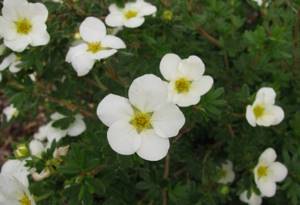
Features of the use of cinquefoil in landscape design
Perennial cinquefoil is actively used in ornamental gardening. The scope of its application in this case depends on the variety. As a rule, the plant is planted in mixborders or in groups.

Low-growing pink, yellow and white cinquefoils look great in alpine slides and rockeries. In flower beds they can be combined with other plants. In some cases, in open ground, cinquefoil is used to create hedges.
Yellow flowers
Yellow Cinquefoil varieties include Goldstar, Golden Dwarf, Goldfinger and Darts Golddigger.
Golden Dwarf is a bush up to 70 cm high, with many reddish branches and golden flowers up to 3 cm in diameter.
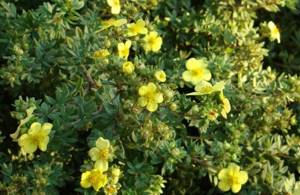
The Goldstar variety has flowers with a larger diameter, up to 5 cm. The buds bloom from mid-summer. The plant blooms until September.
Varieties of Darts Golddiggery Goldfinger (goldfinger) bloom most abundantly and for a long time - from June to October. The bushes are about 1.5 m in height. They have large flowers of an amber hue.
Reproduction of Cinquefoil bush
The simplest solution is to propagate Cinquefoil Shrub by cuttings. It is recommended to carry out cuttings in June; for this, cuttings up to 13 centimeters in length are prepared. Be sure to remove all foliage on them, leaving the bark intact. The cuttings are immersed in liquid fertilizer, remain in it for 12 hours, and then planted in a prepared container with drainage made of fine crushed stone and expanded clay. Each cutting is buried 4 centimeters. The soil mixture is prepared from leaf soil, peat and sand.
The container where the cuttings will be planted must be covered with perforated film. Watering of plantings is carried out once every 2 days. It is recommended to fertilize them once a week, using liquid humic fertilizer to stimulate the formation of roots. The formation of the root system is usually observed after 2 months.
Learn more about the propagation of Cinquefoil Bush by cuttings in this video
Another option for propagating Cinquefoil shrubby is to divide the bush. In spring, you can dig up a bush (over 4 years old) and remove the earthen lump. Disinfect the pruning shears, then use it to divide the rhizome into parts so that you get 2-3 buds on each bush. Sections can be treated with crushed activated carbon. Planting is carried out in fertilized soil, the root collars remain 1.5 centimeters above the ground level.
Another option for obtaining a new Kuril tea plant is the use of layering. In August you will need to pick up an adult bush and cut off 10 centimeters from each layer. A hole is dug under each seedling, fertilizing is added, and it is spilled with warm water. Each layer is buried 10 centimeters deep and pinched to the soil. To give the plants a vertical direction, dig a peg next to them and carefully attach the layer to it.
Cream flowers
These are Guilford Creamy Primrose Beauty varieties.
Guildford Cream grows up to 60 cm. It is a wide bush with a crown diameter of 1 m, it has bright emerald leaves and cream flowers that begin to appear in May. The plant finishes blooming in September.
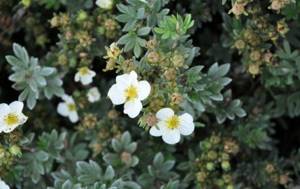
Primrose Beauty is a ball-shaped bush with a crown diameter and a height of 1.2 m. It has many small cream flowers.
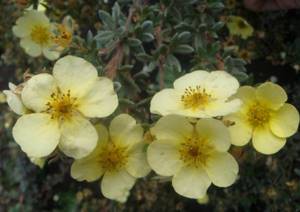
Cinquefoil shrub: the best varieties
Today, there are a large number of varieties of Kuril tea, which are used in the design of dachas, personal plots, parks and squares.
- "Manchu." The height of the bushes of this variety is only 40 cm, and the crown width is about one meter. The whitish flowers with a delicate cream tint bloom from June to September.
- Tilford Cream. The height of the spreading bush varies from 0.35 to 0.6 meters, and the width - from 1.0 to 1.2 meters. Light green leaves cover the plant from top to bottom. Cream-white flowers bloom in May. Flowering lasts until September.
- "Pink Queen" Plants of this variety reach a height of 0.8 meters. The width of the bush is 1.5 meters. Pink flowers bloom on branches covered with bright green leaves. Flowering occurs from June to September.
- "Princesses". The height of the cushion-shaped crown is 0.8 meters and the width is 1.2 meters. The flowers, painted a pleasant pink color, bloom in May. Flowering ends in September. Dark green leaves cover the bush in large quantities.
- “Floppy Disk” is a compact shrub, reaching a height of about 40 cm. The crown width is 0.8 cm. Small light green leaves are located on gray-brown branches. The flowers are 2.5 to 3 cm wide and are pink with a red tint. Powerful flowering lasts from July to September.
- "Red Robin" The bush of this variety reaches a height of 60 cm. The crown width reaches 1.3 meters. Red flowers bloom in July. Flowering ends in September.
- "Tangerine" or "Tangerine". The height of the bush varies from 0.5 to 0.8 meters. The crown width is 1.2 meters. The gray-green leaves go well with the orange flowers (about 3 cm wide) with a golden center. Flowering lasts from June to September.
- Hoples Orange. Plants of this variety grow up to 0.5 meters. The medium-sized flowers are a deep orange color, but when grown in partial shade they turn yellow-orange. Flowering occurs from May to September.
- Abbotswood. The bushes reach a height of 0.8 to 0.9 meters. The width of the crown, shaped like a pillow, is 1.3 meters. A large number of light green leaves cover the bush from top to bottom. The flowers are medium-sized (about 3.5 cm wide) and are pure white. On the branches they are located in inflorescences (small) or one at a time. Spectacular flowering occurs from June to October.

Pink flowers
This is the bush cinquefoil Lovely Pink. This is a low bush with dense foliage and a dense crown; it grows up to 50 cm in height and up to 80 cm in width.
Over the course of a year, the bush grows by about 15 cm. Cinquefoil bush Lovely Pink has a large number of bright pink flowers, which appear from June to October. Flowers do not fade under bright sunlight.
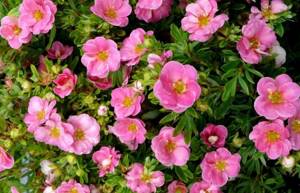
Potentilla fruticosa Pink Queen is a very unpretentious, small shrub with creeping shoots, approximately 0.6 m in height. The variety loves sunlight, but tolerates partial shade. The flowers are faded pink.
Potentilla fruticosa Princesses are bushes that grow up to 80 cm. The variety grows very actively, growing by 10 cm per year. It has fairly large pink flowers, they are up to 5 cm in diameter. Plants prefer to grow in bright sunlight.
Cinquefoil: spring pruning (video)
Feeding and watering
Cinquefoil tolerates drought well, but in order for it to remain decorative, it is necessary to monitor how the soil “feels”. To do this, you should water it at least once every 15 days. In this case, about 11 liters of water are applied to each bush. It should be warm.
Feed herbaceous and other types of cinquefoil immediately after planting at intervals of 3 times per season. To do this, use a solution of mullein and ash, or a complex mineral fertilizer. A good option is to extract vermicompost.
How to prepare for winter
Growing cinquefoil also involves preparing it for winter. But this only applies to young seedlings. They should be covered in advance with burlap before the onset of the cold season, otherwise the bushes will freeze . Over time, yellow and red cinquefoils become more frost-resistant.

How does a plant reproduce?
- The easiest way to propagate a bush in the garden is by layering. To do this, take a shoot, cut it and place it in the ground. It is pinned down, and when it takes root, it is transplanted to a permanent place.
- Another method is propagation by cuttings. They have been prepared since spring: the lower leaves are removed and placed in Kornevin’s solution. Once the root has formed, the plant is rooted in the soil. It is important to cover it with a glass jar and spray it periodically.
- You can also get cinquefoil from seeds. They need to be harvested in the summer. First, the seeds are collected, then dried and placed in paper bags. They can be used for several years. The seeds should be planted correctly - just distribute them over the ridge, but do not cover them with soil, otherwise they will not sprout.
- Cinquefoil can also self-sow. In this case, new small plants are carefully dug up and planted together in a specially prepared bed. After a couple of years they can be planted in a permanent place.
- Hybrid, dwarf and other types of cinquefoil can also reproduce by dividing the bush. In this case, the shoot is separated from the mother plant and then moved to a permanent place.
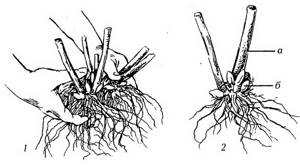
Medicinal properties of the plant
The leaves of the plant can be brewed and drunk. Fresh leaves contain a huge amount of vitamin C, 2-3 times more than in lemons, and a large amount of carotene, as well as essential oils, tannins, catechins, phenolcarboxylic acids.
An infusion of the leaves and flowers of the plant is drunk to treat bloody diarrhea. An infusion of branches is taken for abdominal pain and lobar pneumonia.
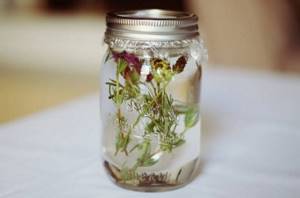
An infusion of the roots is used for pulmonary tuberculosis, scurvy, diseases of the gastrointestinal tract, diarrhea, and staphylococcal dysbiosis.
An infusion from all parts of the plant restores metabolism, it is used as a diuretic, it treats constipation, it is drunk for cystitis and duodenitis. It is used to wash and treat wounds, burns, boils, abscesses, and to rinse the mouth for a sore throat.
Transplanting a cinquefoil bush after purchase into open ground
Hydrangea paniculata white, red, pink - the best winter-hardy varieties
Shrub cinquefoil is planted in the garden in early April (if it is warm, then at the end of March) or in late October - early November before snow falls. It is important to choose a permanent habitat for the plant and have healthy planting material.

Planting a crop consists of certain stages
What is needed for planting
Before planting, carefully inspect the roots of the seedling, if necessary, removing those damaged by pests and dried. If the stems are excessively tall, prune the plant along the way. In addition to planting material, you need:
- drainage for the pit - broken pottery, brick chips, pebbles, coarse sand;
- tools - shovel, bucket of water, gloves, pruning shears;
- growth stimulator;
- mineral and organic fertilizers - compost, manure, humus.
Important! They dig a deep hole, at least 55-65 cm.
Choosing the optimal location
Cinquefoil prefers well-lit areas of the garden, but does not tolerate direct sunlight. Choose a place that is slightly shaded. The bush can be planted near the fence. The optimal distance between bloodroot and other plants in the garden is 60-70 cm.
The soil needs to be slightly acidic, well-drained, and saturated with all the nutrients necessary for flower growth. Potentilla is not planted in wetlands, but its wild species survive in the swamp.
Step by step planting process
Plant according to simple instructions:
- Digging a hole. The depth of the planting hole is approximately 60 cm, width 50-40 cm, but it all depends on the volume of the root system.
- Laying drainage. The bottom of the pit is covered with a layer of pebbles, sand or broken bricks. Layer thickness is at least 5 cm.
- Preparing the earth mixture. Mix turf soil, humus, peat and a little sand.
The roots are freed from the earthen clod, placed in a hole in the center, and covered with earth. The soil around the bush is well compacted. The plant is watered with water (4-5 liters for each bush).
Mister summer resident warns: diseases and pests
The shrub has good immunity and rarely suffers from insects and diseases. But there are a number of pathologies that still affect cinquefoil:
- rust;
- spotting;
- powdery mildew.
If an annual plant is affected, then no measures are taken. In September, the bushes are already thrown away, but the summer decorativeness will not decrease in any way. If there are diseases in perennials, they are treated with fungicides. Colloidal sulfur or Bordeaux mixture works well. Among the pests, the plant is occasionally attacked by cutworms. They are eliminated using insecticides Decis and Fitoverm.
White cinquefoil: beneficial properties and contraindications
White cinquefoil is widely used in folk medicine, because its beneficial properties help combat the following pathologies:
- Problems with the functioning of the endocrine system. Used for the treatment of thyroid diseases and dysfunction. Using cinquefoil, knots are removed and toxins are eliminated from the body.
- Gynecological pathologies. Decoctions of the plant normalize the monthly cycle, resolve uterine cysts and neoplasms (even malignant ones).
- High blood pressure. Helps reduce and normalize the functioning of the heart and blood vessels.
- Obesity. Used to improve metabolic processes.
- Stress. Medications containing the plant have a positive effect on the central nervous system. They eliminate mental disorders, help to survive emotional shocks of varying strength, and relieve depression.
- Abscess. All inflammatory processes of the skin or damage caused by mechanical means go away faster if they are treated with tincture of white cinquefoil.
- Gastritis. Medicines with the addition of the plant have a positive effect on the acidity in the stomach. Relieves acute pain and relieves sensations.
- Diarrhea. Cinquefoil contains tanning components that quickly eliminate this problem.
But, despite all the positive properties of the plant, there are also contraindications to the use of drugs based on it:
- low blood pressure;
- colitis that accompanies atomic constipation;
- urolithiasis (the plant provokes the movement of stones that get stuck in the ureter and cause an inflammatory process in the organ);
- carrying a baby (bleeding occurs, which negatively affects the baby’s condition);
- lactation (the effect of the flower on the child through mother’s milk has not been studied, so experts do not recommend taking risks).
If we take into account all the contraindications to the use of cinquefoil, then the plant can relieve many pathologies. And with quality care, it will also delight you with its flowering for a long time.






